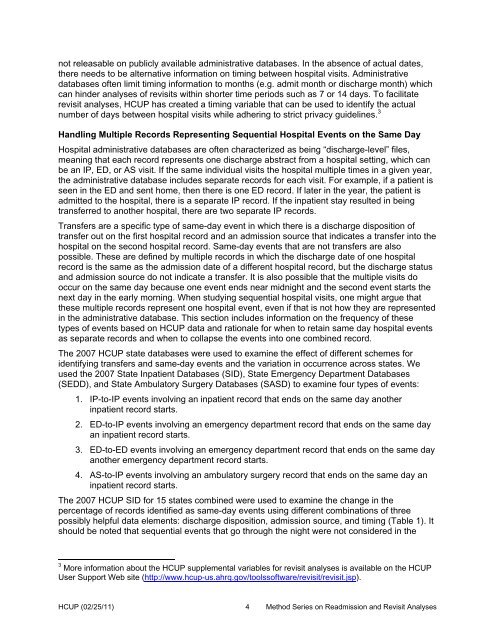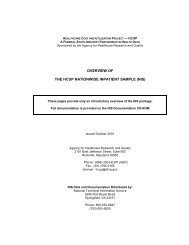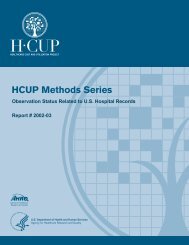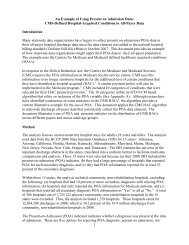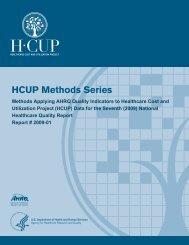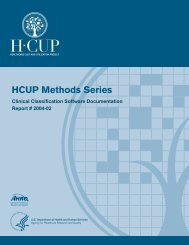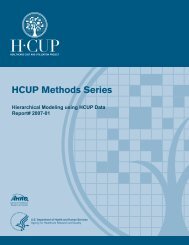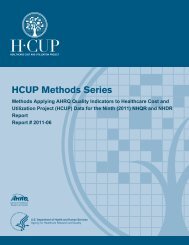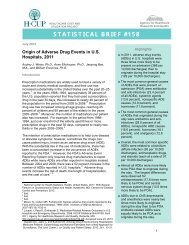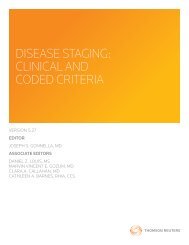Inconsistencies in PIDs across calendar years of data still exist because <strong>HCUP</strong> data partnershave changed their coding schemes. Between 2004 <strong>and</strong> 2007, four of the 17 states that havesynthetic person identifiers in the <strong>HCUP</strong> state databases have refined their creation of syntheticPIDs because of differing interpretations of how to apply the Health Insurance Portability <strong>and</strong>Accountability Act (HIPAA) restrictions to the release of this type of person-related information.Even if the PIDs are consistently coded across years <strong>and</strong> hospital settings, it is advisable toconfirm that PIDs are consistently coded for the population of interest (e.g., age, insurance,hospital type, etc.). For example, in the <strong>HCUP</strong> state databases, there is limited availability inPIDs for pediatric patients in some states, but good availability (greater than 90 percent) foradult patients in all possible states. Availability of PIDs for patients covered by different types ofinsurance can also vary by state. 2Selecting the Hospital Settings for a Revisit AnalysisWhen studying repeat hospital care, careful consideration needs to be given to the choice ofhospital settings. Many studies have focused on inpatient readmissions, but that may not alwaysprovide the most complete picture of hospital care. For example, if studying a chronic conditionsuch as asthma it might be advantageous to include inpatient stays <strong>and</strong> emergency departmentvisits that do not result in admission because treatment for asthma occurs in both settings. Ifstudying inpatient treatment for an acute condition such as acute myocardial infarction (AMI), itmight be interesting to look forward in time at inpatient readmissions or back in time for anemergency department visit in which the heart condition was misdiagnosed. In addition,complications of ambulatory or short-stay surgery may present in the emergency department<strong>and</strong> be stabilized <strong>and</strong> released home or admitted to the hospital.The majority of the journal articles we reviewed (69 percent) studied only inpatientreadmissions. Another 17 percent utilized both inpatient <strong>and</strong> outpatient data. Summary countsare shown in Appendix B.Deciding on the Number of Data Years to IncludeThe number of data years to be included in a study period for an analysis of revisits depends onthe time interval that will be allowed between multiple visits. For example, in a study of repeathospital visits within three months that uses only one calendar year of data, events of interestcan only be identified for the first nine months of the year (January through September). Thelast three months (October through December) are reserved for identifying the repeat visits forpatients with a first event during the June to September period. If the event of interest is rare, acalendar year study period may be insufficient to obtain an adequate sample size. About half ofthe journal articles we reviewed (47 percent) used a time period of three or more years. Twentyeightpercent used a one year study period. The lengths of study periods used in studies wereviewed are detailed in Appendix B.Identifying the Time between Hospital VisitsThe final consideration in choosing an appropriate administrative database to study revisits isthe availability of information on the time interval between hospital events. Because of HIPAAguidelines on protecting patient confidentiality, dates of admission, discharge, <strong>and</strong> treatment are2 Steiner, C. (AHRQ), Barrett, M. (M.L. Barrett, Inc.), <strong>and</strong> Hunter, K. (Thomson Reuters). Hospital<strong>Readmissions</strong> <strong>and</strong> Multiple Emergency Department Visits, in Selected States, 2006–2007.. <strong>HCUP</strong>Statistical Brief #90. May 2010. Agency for Healthcare Research <strong>and</strong> Quality, Rockville, MD.http://www.hcup-us.ahrq.gov/reports/statbriefs/sb90.pdf. (Accessed August 7, 2010).<strong>HCUP</strong> (02/25/11)3Method Series on Readmission <strong>and</strong> Revisit Analyses
not releasable on publicly available administrative databases. In the absence of actual dates,there needs to be alternative information on timing between hospital visits. Administrativedatabases often limit timing information to months (e.g. admit month or discharge month) whichcan hinder analyses of revisits within shorter time periods such as 7 or 14 days. To facilitaterevisit analyses, <strong>HCUP</strong> has created a timing variable that can be used to identify the actualnumber of days between hospital visits while adhering to strict privacy guidelines. 3H<strong>and</strong>ling Multiple Records Representing Sequential Hospital Events on the Same DayHospital administrative databases are often characterized as being “discharge-level” files,meaning that each record represents one discharge abstract from a hospital setting, which canbe an IP, ED, or AS visit. If the same individual visits the hospital multiple times in a given year,the administrative database includes separate records for each visit. For example, if a patient isseen in the ED <strong>and</strong> sent home, then there is one ED record. If later in the year, the patient isadmitted to the hospital, there is a separate IP record. If the inpatient stay resulted in beingtransferred to another hospital, there are two separate IP records.Transfers are a specific type of same-day event in which there is a discharge disposition oftransfer out on the first hospital record <strong>and</strong> an admission source that indicates a transfer into thehospital on the second hospital record. Same-day events that are not transfers are alsopossible. These are defined by multiple records in which the discharge date of one hospitalrecord is the same as the admission date of a different hospital record, but the discharge status<strong>and</strong> admission source do not indicate a transfer. It is also possible that the multiple visits dooccur on the same day because one event ends near midnight <strong>and</strong> the second event starts thenext day in the early morning. When studying sequential hospital visits, one might argue thatthese multiple records represent one hospital event, even if that is not how they are representedin the administrative database. This section includes information on the frequency of thesetypes of events based on <strong>HCUP</strong> data <strong>and</strong> rationale for <strong>when</strong> to retain same day hospital eventsas separate records <strong>and</strong> <strong>when</strong> to collapse the events into one combined record.The 2007 <strong>HCUP</strong> state databases were used to examine the effect of different schemes foridentifying transfers <strong>and</strong> same-day events <strong>and</strong> the variation in occurrence across states. Weused the 2007 State Inpatient Databases (SID), State Emergency Department Databases(SEDD), <strong>and</strong> State Ambulatory Surgery Databases (SASD) to examine four types of events:1. IP-to-IP events involving an inpatient record that ends on the same day anotherinpatient record starts.2. ED-to-IP events involving an emergency department record that ends on the same dayan inpatient record starts.3. ED-to-ED events involving an emergency department record that ends on the same dayanother emergency department record starts.4. AS-to-IP events involving an ambulatory surgery record that ends on the same day aninpatient record starts.The 2007 <strong>HCUP</strong> SID for 15 states combined were used to examine the change in thepercentage of records identified as same-day events using different combinations of threepossibly helpful data elements: discharge disposition, admission source, <strong>and</strong> timing (Table 1). Itshould be noted that sequential events that go through the night were not considered in the3 More information about the <strong>HCUP</strong> supplemental variables for revisit analyses is available on the <strong>HCUP</strong>User Support Web site (http://www.hcup-us.ahrq.gov/toolssoftware/revisit/revisit.jsp).<strong>HCUP</strong> (02/25/11)4Method Series on Readmission <strong>and</strong> Revisit Analyses
- Page 1 and 2: HCUP Methods Series
- Page 3 and 4: TABLE OF CONTENTSIntroduction .....
- Page 5: • Revisits - repeat hospital visi
- Page 9 and 10: There are two options for handling
- Page 11 and 12: Medicare and Medicaid are considere
- Page 13 and 14: cause. Within one month, the percen
- Page 15 and 16: characteristics can change over tim
- Page 17 and 18: APPENDIX A. HCUP DATA PARTNERSOnly
- Page 19 and 20: APPENDIX C. LITERATURE REVIEW: STUD
- Page 21 and 22: de Lissovoy G, Zodet M, Coyne K, O'
- Page 23 and 24: Lichtman JH, Jones SB, Watanabe E,
- Page 25 and 26: Yermilov I, Bentrem D, Sekeris E, e
- Page 27 and 28: Principal Findings: Among the patie
- Page 29 and 30: Results: Among patients with diabet


